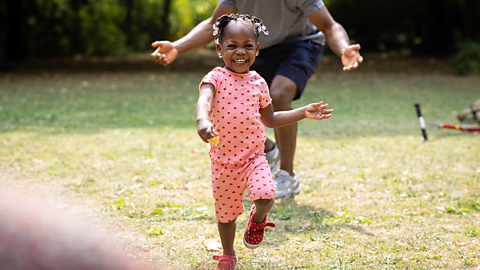If youãre the parent of a toddler, chances are youãve seen the odd wobble, tantrum or full-blown meltdown. But how can we deal with these situations?
ãParents need to understand that behaviour is a form of communication.ã Thatãs the verdict of educational psychologist Dr Alison Gurney. When your child is acting up, itãs not always that they are choosing to be defiant. Instead, they are either trying to tell you something that they donãt have the words for yet or otherwise theyãre looking to assert their independence.
ãRather than just going straight in and thinking ãhow can I control this behaviour and how can I manage it?ã, the first thing that parents need to be thinking is actually ãwhat's my child trying to tell me by acting in this way?ã
Parents need to understand that behaviour is a form of communication.

Emotional validation and understanding
With this in mind, how can parents look to correct behaviour they donãt want to see?
ãThere's two key factors that are really important. The first one is warmth, making your child feel loved and safe and a sense of belonging. The second is limit-setting, making sure that you're putting boundaries in place for things that aren't appropriate. Sometimes we can jump straight to setting limits at the cost of warmth.ã
According to Alison, itãs important that children understand that theyãre allowed to feel negative emotions, like being angry or scared. ãA key message is to try not to give your child the sense that they shouldn't be feeling those ways. This means to stop saying things like ãstop feeling sorry for yourselfã or ãthere's no need to get upsetãã, she says.
Instead, Alison encourages parents to connect with children emotionally before correcting behaviour, an approach called ãemotion coachingã.

Emotion coaching ã the 4 steps

When it comes to dealing with tantrums there are 4 main steps to the emotion coaching approach.
1. Tune into your childãs feelings (and your own)
ãWhen your child is behaving in a way that you don't want, you've got to tune into what they might be feeling and also what you're feeling,ã says Alison.
Letãs take an example: say you wanted your child to stop playing with their toys and come and have lunch, but despite asking nicely, they throw a bit of a strop and start throwing their toys around.
The first step is to take note of how youãre both feeling: ãtheyãre upset because they were really enjoying themselves and you've come in and interrupted. At the same time, you've got lunch on the table and now it's going cold, so youãre frustrated too.ã
2. Recognise the learning opportunity
This means taking a deep breath and thinking about what you might be able to teach your child in this situation about their emotions and behaviour.
ãItãs sort of making a promise to yourself ã ãactually I'm going to use this as a learning opportunity, I'm not just going to dive straight in with ãwe're not doing thatãã, explains Alison.
3. Name your childãs feelings
The third step involves showing your child that youãve recognised how they feel and letting them know that itãs ok to feel that way.
ãYou might say something like ãyou look a little bit cross because Iãve asked you to finish playing with the toys. It's okay to be cross sometimesã.ã
By naming the feelings, your child will start to link how they feel with the words that you use.
4. Explain how you want them to behave
This is where you set limits on how your child is behaving.
ãIf you want to teach your child that that's not the appropriate way to behave, then give a reason for why they shouldn't do it and explain what you want them to do instead.
"You might say, ãI can see youãre upset - youãre throwing toys around the room. Mummy/Daddy doesnãt like it when you do that. They could hurt me. We need to keep the toys on the floorã.
ãI want you to finish playing because it's time for lunch now. Should we leave the toys here so they're ready when we come back?ã.ã

Why it's useful
Taking a moment to stop and think things through can lead to the best solution for you both. ãIn our example, if you hadnãt taken the time to stand back and realise the child is frustrated and think about why, then you might not have realised that actually, if they knew they could come back to the activity, then that would make them feel better and more likely to go along with it.ã
Even if your child is throwing a tantrum in public, itãs worth going through the whole process, says Alison. ãEven though it can be embarrassing, you wonãt be the only parent who has experienced it,ã she reminds us. ãI would say that although itãs probably going to be much harder in a public place, keeping calm and trying to follow the 4 steps has the best chance of success.ã This is because children are more likely to go along with the limits you set when they feel like theyãre being listened to and that their emotions are normal.
Avoiding tantrums

According to Alison, over time youãll get better at tuning into what your child is trying to tell you and taking steps to avoid tantrums. But itãs also important to help toddlers grow more independent.
ãKeep a close eye on what your child is able to do, because at this age they're progressing so quickly. From one month to the next they might suddenly be able to pull their shoe on and pull the Velcro across, for example. As a parent youãre often rushing around on your own schedule, but try to allow your child time to develop certain skills and catch yourself when you're trying to help them or do it for them.ã
This can pay off in terms of behaviour, says Alison.
Often, when a parent has backed off a bit and has given the child more space and more room to exert their independence, then you see a lot less battles.

Advice if youãre struggling
If youãre worried about your childãs behaviour, then itãs important to keep a check on yourself. ãMake sure that if you're feeling a bit wobbly, then you're reaching out and talking to family and friendsã, Alison says.
It might seem difficult, but try and speak to other parents about childrenãs behaviour too. ãI would bet my bottom dollar that if you talk to another parent about a tantrum, you'll find that they will share their experiences.ã
Itãs worth remembering that tantrums are completely normal behaviour for young children as they develop their understanding of their feelings and what to do with them. However, if youãre not sure, then itãs worth seeking advice. ãTalk to your health visitor. They have additional training in behaviour and the social/emotional needs of children and they're often very open to supporting families with this.ã
If your child is in settings like a nursery or childminderãs, then maybe ask whether theyãve noticed anything too. ãThat way you'll be able to come up with a plan together rather than you just worrying about it, not having talked to anyone.ã






